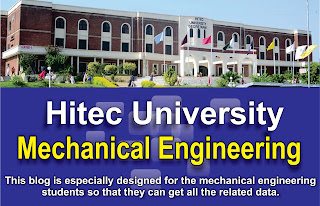Showing posts with label Thermodynamics. Show all posts
Thermodynamics 2
By : Asad Ali Arshadthermo-lab-1.docx
null
Thermodynamics
Branch of science that studies changes in energy.
Temperature, Pressure, Volumeare driving forces for energy.
Types of Heat
(1) Latent Heat:
Related to phase change i.e. melting of ice. Boilers, Evaporator.
(2) Sensible Heat:
Heat can be sensed (No phase change) e.g. Heaters. Air conditioners.
Laws of Thermodynamics
First Law of thermodynamics:
Energy can neither be created now destroyed but it can be changed from one form to another.
Also called law of conservation of energy.
ein-eout=constant
ein=eout
ΔU=Q+W
Q= Heat exchanged b/w system.
W=Work done.
 |
Second Law of thermodynamics:
Entropy of a system also increases never decreases.
Entropy:
Measure of disorder of energy of a system.
Zeroth Law of thermodynamics:
Kelvin Statement
No device can be worked with single reservoir. .e.g. car-engine.
Clauses Statement
Heat cannot be transferred from low to higher reservoir. E.g. refrigerator
Second Law of thermodynamics:
For a pure crystalline structure entropy is zero at absolute zero.
Microscopic Properties:
Study of each atom or molecule separately.
Macroscopic properties:
Study of each atom or molecule as whole average.
System:
Anything under consideration is system.
Surrounding:
Everything except system is surrounding.
Boundary:
The separation b/w system and surrounding is boundary.
Closed System:
A fixed amount of mass is chosen for study.
Open System:
Thermodynamic
By : Asad Ali ArshadChapter no 7: Entropy
Entropy may be understood as the measure of disorder within the microscopic system.
chapter 7.pdf
null
Book:
Thermodynamics: An Engineering Approach by Yunus A.Cengel, Michael A.Boled 5th Edition
In this chapter we will discuss the following topic and these topic are discussed in detail in the above slides.
- The inequality of Clausius (for irreversible cycle and for reversible cycle).
- Entropy A property of the system
- Internally Reversible Isothermal Heat Transfer Processes
- The increase of entropy priciple
- Some remarks of about entropy
- Problems
- Entropy of water
- Entropy change of pure substances
- Isentropic process
- Property diagrams involving entropy
- What is Entropy?
- Entropy change of solids and liquids
- Entropy change of ideal gases
- Problems
Thermodynamics
By : Asad Ali Arshad |
| Thermodynamics |
Chapter no 5: Mass Energy Analysis of Control Volume
chapter 5.pdf
null
In this chapter we will discussed the following topics in detail:
- Energy Analysis of Steady flow
- First law of thermodynamics for a Control Volume under steady flow
- Mass and Energy balance for a steady-flow Process
- Some Steady flow Engineering Devices
- Turbines and Compressor
- Throttling value
- Heat Exchanger
Thermodynamics
By : Asad Ali Arshad |
| Chapter no 4 |
In the below given file there are the solution of whole chapter no 4 of thermodynamics 6th Edition
solution 4.pdf
null
Thermodynamics
By : Asad Ali Arshad
Chapter no 4 : Energy Analysis of Closed System
In this chapter we will cover the following topics:
- Moving Boundary Work
- Total Boundary Work its process and graph
- Boundary work for a constant volume process isochoric
- Boundary Work for a constant pressure process isobaric
- Polytropic Process
- Specific Heat
- Specific Heat at constant volume and pressure
- Internal Energy, Enthalpy and Specific Heat for Ideal Gas
chapter 4.pdf
null
Thermodynamics
By : Asad Ali ArshadIn the following pdf file all the solutions of of chapter no 3 are given.
Chapter 3 solution.pdf
null
Thermodynamics
By : Asad Ali ArshadIn these slides Dr.Zahid Iqbal suggest some number of question from exercise to solve by the student and hopefully in sessional 1 the these question may come.
Problems.pptx
null
chapter 1 problems.pdf
null
Tag :
Thermodynamics,
Thermodynamics-1,
Thermodynamics
By : Asad Ali ArshadChapter no 3 : Properties of Pure Substance
This chapter contain the following topics and in the given slides we will discuss these topics in details.
- What is a Pure Substance?
- Phases of Pure Substance.
- Phases Change Process of Pure Substance.
- Property Diagram for Phase Change Processes.
- Properties of Pure Substance(This topic is the heart of this chapter and we will discussed it in a very detailed way).
- Properties Tables.
chapter 3 (1).pdf
null
Thermodynamics
By : Asad Ali Arshad
Download the thermodynamics 8th edition by using the following link....
https://www.sendspace.com/file/st9j75
https://www.sendspace.com/file/st9j75
Hitec Mechanical Engineering
Mechanical Engineeirng Hitec Mechanical Engineering As we know Mechanical Engineering is the branch of engineering dealing with the des...


















